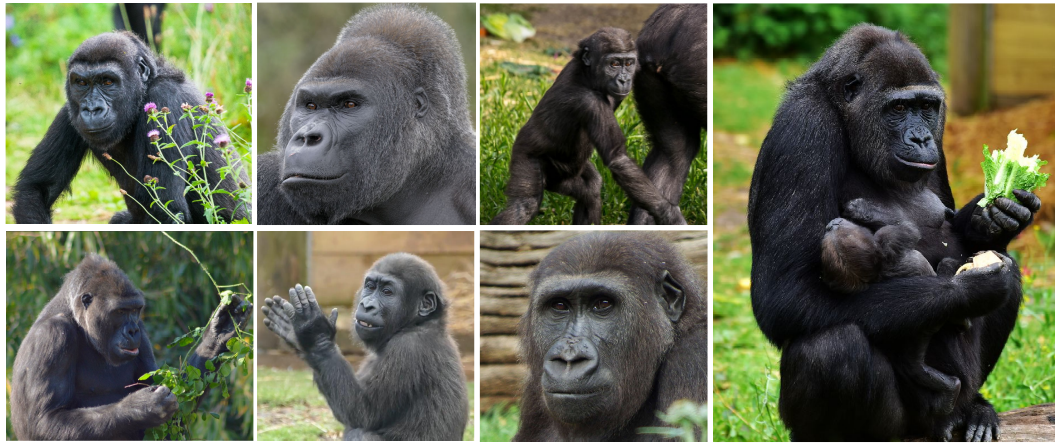An image dataset for the facial recognition of western lowland gorillas (Gorilla gorilla gorilla): the dataset comprises 5k+~facial bounding box annotations across a troop of 7 gorillas at Bristol Zoo Gardens.
The reported results were produced using the darknet implementation of YOLOv3. The precise implementation can be found here.
- The dataset is stored using Git Large File Storage and this need to be installed (instructions can be found here) before the repository can be cloned (downloading the repository as a zip file won't work, unfortunately).
- To reproduce the results the forked darknet repository will need to be installed. I have provided the neccessary files to evaluate the network once this has been done. The
darknet_filesdirectory includes theyolo-obj.cfg,obj.names,obj.data,train.txt,test.txtand.weightsfiles that are needed. The How to train (to detect your custom objects) section of the darknet repository will tell you where to put these files. Once the files are in the correct location rundarknet.exe detector map data/obj.data yolo-obj.cfg backup\yolo-obj_best.weightsfrom the directory where the darknet executable file is located - this will produce the desired mAP calculation. For more details on evaluation refer to the When should I stop training section (specifically subsection 2.2).
- The
images/directory contains all of the data and is already split intotrain/andtest/sets. - Each of the splits has a subdirectory for each gorilla (for example,
afia/,jock/orkala/. - Each of the gorilla directories contains both images and annotations; this is because the darknet framework requires that images and annotations be placed in the same directory at training time.
- All images are JPEG format (
.jpg) - Annotations are text files (
.txt) - Annotation format:
<class> <x> <y> <width> <height><class>= integer representing the object class<x>= x-coordinate of the centre of the objects' bounding box<y>= y-coordinate of the centre of the objects' bounding box<width>= width of the bounding box<height>= height of the bounding box
AlexeyAB's comment on this Github issue is very useful in providing clarification on the annotation format.
The network weights are .weights files (a custom darknet format) and can be found in the network_weights/ directory
- The
videos/directory contains all the videos in the dataset. - Each gorilla has a directory (for example,
afia/,jock/orkala/) and many subdirectories (for example,afia/afia-2-2orkala/kala-0-4) - The suffix
ie -2-2of the subdirectories originally related to the video number and the week from which the video footage was gathered, respectively - Within the subdirectory there is the video file of the same name (for example
afia-2-2/will contain the videoafia-2-2.mp4) and the annotation file. - All video files are MPEG-4 Part 14
.mp4 - The annotation files are
.txtand have the same format as the image annotations (described above). - The annotation is named after the frame for which an annotation exists (for example
frame186.txt). That is, the class and bounding box coordinates relate only to the 186th frame of the video (although it is likely it would still be relevant for the frames immediately either side).
This work was presented at the Visual observation and analysis of Vertebrate And Insect Behaviour workshop at the International Conference on Pattern Recognition (ICPR 2020). If you use this work as part of your research, please cite A Dataset and Application for Facial Recognition of Individual Gorillas in Zoo Environments.
@misc{brookes2020BristolGorillas,
title={A Dataset and Application for Facial Recognition of Individual Gorillas in Zoo Environments},
author={Otto Brookes and Tilo Burghardt},
year={2020},
maintitle={International Conference on Pattern Recognition 2020},
booktitle={Workshop on the Visual Observation and Analysis of Vertebrate and Insect Behaviour},
eprint={2012.04689},
archivePrefix={arXiv},
primaryClass={cs.CV}
}
We would like to acknowledge the contributions of our collaborators for their help in facilitating the technical innovation described in this paper. Specifically, we’d like to thank the other members of the Gorilla Game Lab team, Dr Fay Clark, Dr Katy Burgess, Dr Peter Bennett, and Dr Stuart Gray for their efforts. We would also like to extend our thanks to the staff at Bristol Zoo Gardens, most notably to the keepers, and to Betty Roberts.
If you require any assistance or are interested in this research, please do not hesitate to email me.
